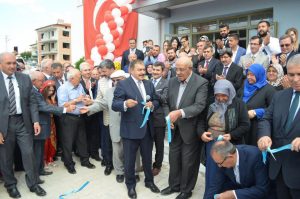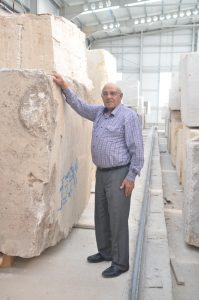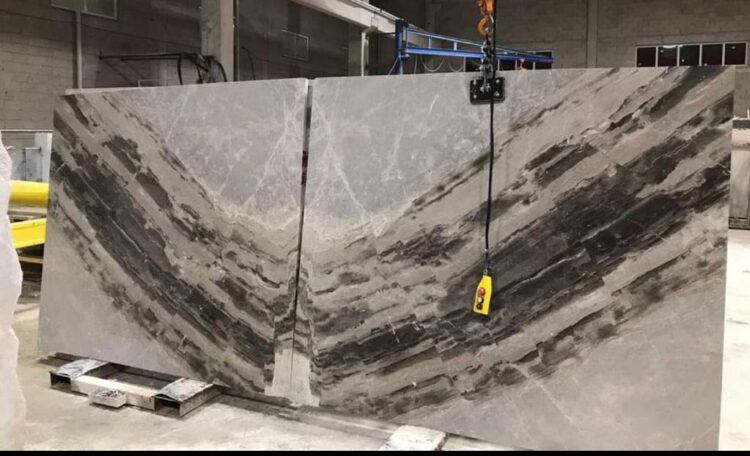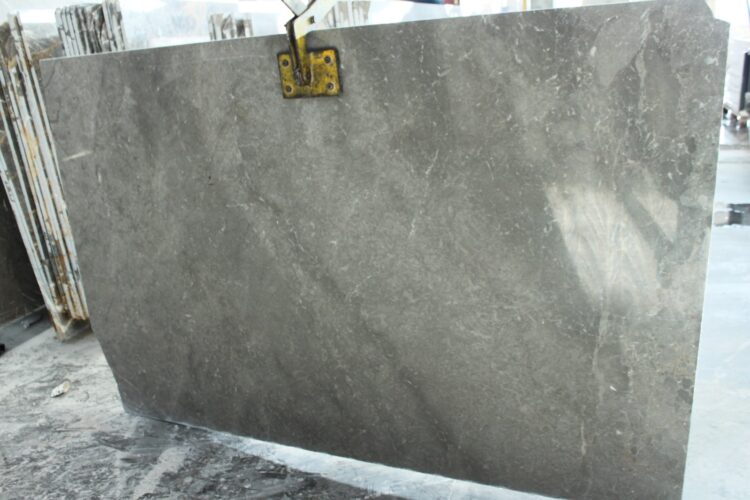One of the leading names in the sector is our guest in Afyon Iscehisar. His name and surname are written as Mehmet Ozcan in his identity, but everybody in this sector knows him by his nickname …
There is no doubt that the veterans of this sector have made a great contribution in the development of the marble sector in Turkey. Afyon is the base of many firsts in this sector. In this issue, we will try to introduce a contributor to you. You will remember him by his nickname “Karamehmet”. Yes, we are going to tell you about the 80 years old sectoral veteran Mehmet Özcan, known by his nickname “Karamehmet”. He still has the same excitement to contribute to the sector.
When and where did you first enter this sector?
In 1950, after I finished primary school, I started this business. I didn’t have enough opportunities to study further. It wasn’t easy to find a job at that age at that time. But I had a close relative, who hired me because I was very hard-working. I started working at Alimoğlu’s quarry. I went to the military in 1957. I made 24 months of military service in Amasya. After coming from the military in 1959, I continued working in Alimoğlu again. In 1961, we opened our own quarry in Iscehisar. At that time, we used to break the stones with 10 centimeters wide and 30 centimeters deep iron plates and split some stones from the middle manually. We used to take them out in two parts on the same day, but it usually took us a week to remove some stones. We had no other power than our hand power. We were even lifting 20 to 30 tons of rocks with lifting jacks. We were making ramps to carry them and load them into cars through lifting jacks. Then I opened a travertine quarry in Denizli .. Then travertine has become popular after I received a travertine quarry license. After Alimoglu had received a quarry license, travertine production started in the region. It was also difficult to sell travertine at that time. We were taking travertine from Denizli to İstanbul in seven days and to Ankara in 4 days. As there were a few marble producers in the sector, we carried out our business under such difficult conditions. We bought a compressor in 1968. We were piercing the holes with the compressor. In 1974, I was the one who brought the 955-brand earth dipper to Afyon first. We found someone to export our products and, then it went on like this.
Was it the Afyon stone you were exporting?
We were exporting Afyon stone. We did not make any exports from our Denizli quarry.
Were you selling only blocks at that time?
Yes, we were just producing and selling blocks to factories in Ankara, Izmir and Istanbul.
How did you start factory production?
From 1975 to 1985, I slowed down my marble business and made contracting business. During this period, we were only engaged in quarry business in marble sector. After 1985 – 1986, we paid more attention to marble production. I started making factory production after we made a factory investment. We were selling all the stones as blocks until that investment. In the same period, we established a factory. Then we opened the second and third factories. Our quarries in Denizli were doing well. We established a factory in Denizli after 1990. We were selling all the stones as blocks until we built that factory. It seemed more affordable to sell blocks at that time. In our first factory in Afyon we had two STs. Then we bought simple sandy gang saws. After 1990, my son Remzi and his brother joined the business so that they could make better production and marketing in the factory.
Have you ever been abroad?
I did not go, but my children are going abroad. I couldn’t find any opportunity for that. I want my children to live well and do anything they can. Thanks God we have seen these days. My children are also taking care of my business well. Our factory in Denizli is also in good condition. It is located in a very beautiful place of Denizli, with a waterfall in front of it. Both my factories and quarries in Denizli and Afyon are doing well.

When you entered the sector, did you dream of building factories and enlarging the business?
Of course, I dreamt of such things but not only for myself. I wished same quarries and factories for other people in the region as well. To this end, I’ve made at least 20 partnerships by presenting capital and knowledge. Fortunately, my former partners own their own factories and quarries today. Lucky me they all still show respect me. There were no factories in Afyonkarahisar before. We established the first factory in Afyon as İscehisar Marble Producers Cooperative, which was running under my presidency. God gave us courage. I did not have any money but we could manage ourselves since I worked honestly.
When did you establish the cooperative?
We improved the capacity of the cooperative until 1972. People who managed it before me couldn’t achieve much more than planting trees. Then, they chose me. When I was elected as the president, I went to Ankara. At that time there was Afyon deputy and Deputy Prime Minister Hasan Dinçer. I knew him well. He even made my advocacy at a time. I went to Ismet İnönü, the Prime Minister of that time. He said, “You’re talking about the cooperative but nothing has been done for three years.” I told him that I was the new president and told him about our problems. He already knew this region well. So we started to build up the cooperative. I was one of the contributors in the establishment of this cooperative. I could have established it by myself but at that time, I was busy with quarry operations. Everybody started to call me as Karamehmet back then. Then Karamehmet became my nickname. In fact, I had established a company called Özcanlar Marble, but people kept calling me Karamehmet.
They gave you the nickname Karamehmet for your sun-tanned skin while working in the field, didn’t they?
We had many difficulties while working in the quarries. There where no vehicles back then. We used to walk 10 kms everyday to reach the quarry. There was not any catering either. We worked under difficult conditions. Maybe it’s because of my skin colour but I think my nickname is given me for my sincerity, my righteousness, my desire to work together and my fatherhood.
Did you have any support from the government?
We did not get any support from the government. We started using machines after 1970. If considered as a support, sometimes we bought diesel oil for account we continued working like this. My children hardly believe my story. We would mine huge logs with our manual power. We used to swage the logs for days in order to shape them. In 1971, I met Bekir Yıldırım, an exporter. Our meeting was as follows: I was in Istanbul to see some people. At that time, we had a white marble quarry. My friend in Istanbul told me about a person who was looking for me, as he wanted to export my stone. We called him and he came in ten minutes. I told him that I didn’t have any financial power and that I could provide him my stone if he helps me export it. He gave me advance money of 50 thousand liras according to that time’s currency. We got our third and fourth compressors with that money. He told me not to worry about money. We shipped our stones to him and he exported them. We continued working with him for four or five years. He was selling our stones to a customer in Beirut. Of course, there were government incentives in that period, but according to me what accelerate the development of the sector, started when quarry licenses were taken from the private sector and given to the department of mines. This paved a way for the establishment of factories. Then the sector started to make export and now it is in its current position. Thank goodness, we are in a good position in the sector.
When did you use the first diamond wire in quarries?
The diamond wire has a 20, 25 years history. This first machine of this type came to us from Bulgaria. That machine had five hundred meters of wire, which turns, hangs on the stone, cuts and goes on. It was useful for us. Now there are latest model machines in the sector. Nothing is done manually anymore. Wires cut separate and wash.
For how many years have you actually been in this industry?
I have not traveled much this year. I traveled almost every place in Turkey. I’ve been everywhere. I went to Diyarbakır, Van Başkale, Trabzon, Zonguldak, Kastamonu, Samsun, Adana, Bartın, Mersin, everywhere. I had many acquaintances in many places. We are looking for quarries with their recommendations.
In which cities do you have quarries?
We have quarries in Eskisehir, Afyon, Bursa, Denizli, Burdur, Isparta, Konya, Şuhut, Karaman, Bilecik, Sivas, Kayseri, Antalya, Eskişehir and Aydın. There must be more than 100 quarries that were opened with my contribution. I am having some problems due to my age. I cannot walk too much. I go to places where I can go by car. I want to go everywhere but it is not possible anymore. I have worked so hard. I made great efforts for other marble producers in the sector. Today’s marble producers in Afyon, did not know what marble was in the past. Karamehmet toughed them this business. People used to count my freight trucks in the past. Fortunately, today there are many trucks carrying the marble of other marble producer companies in the region.

You have given your heart to marble …
Sure, we gave a heart to marble. I’ve lost a lot of things, but I always go straight. I’ve been through two big bad incidents. I did not only work for myself, but also for other producers and companies in the sector. I helped many people increase their trade volumes.
How many children and grandchildren do you have?
I’m 80 years old. I was born in 1936. I have eight children. I have 3 boys and 5 girls. All of them are married except for the youngest one. I do not know the exact number of my grandchildren; I suppose I have 20-30 grandchildren. They come and visit me on holidays.
Why have you never been abroad? Why did not you visit the city of Carrara in Italy in particular?
Let my children go and visit. They are now going to America, China. Italy, Germany, France, Saudi Arabia and India. They always tell me to go with them but I don’t. This is my place. I come and drink my coffee. I get in my car and go home. I’m not working actively anymore. I spend more time on charity and social matters. In 2016, we built a school with 12 classrooms and delivered it to the Ministry of National Education.
You have traveled many quarries in Turkey. Was there any quarry that you couldn’t own although you really liked it?
I have visited many quarry fields. Sometimes we could obtain good stones from quarries we didn’t expect to be good. For example, there are lands, which are sold to 500-550 dollar/tons. Everything has changed along with technology. Today, everything is possible. Through technology and knowledge, you can turn a muddy field into a productive quarry. In the past, white and black marble and travertine were popular. Beige was not on demand. Now beige is also popular. Everybody buys beige.
You like white marble, don’t you?
In the past, people were coming to Afyon for its famous white marble. We were selling high amount of white marble. To be honest, Afyon white is a beautiful and good quality marble.
Was travertine on demand back then?
Not very much. The amount of travertine was limited as well. Later on, travertine export has started. Then it became popular especially in the American market. We were mainly producing travertine in the periods of its popularity. We exported travertine to many markets including America. After Chinese marble sector showed great interest to Turkish stones, we focused on beige production.
Do you regret for anything? Is there anything you want to add?
We are a little late in some business. We have not kept some of the quarries. Now those quarries become popular. The current owner of one of the quarries we couldn’t keep, is making 20-30 million TL in a year. I just wanted to give an example of an opportunity we missed. In every period, different colours and regions become trendy in natural stone sector. On the other side, we can’t deny the contributions of China to our marble sector. Chinese marble purchasers have been keeping our sector up and running for the last 10 years. That’s what marble business is!
Interview: Ersin BOZKURT


























 +90 532 585 51 95
+90 532 585 51 95 +90 532 585 51 95
+90 532 585 51 95